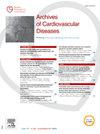Tricuspid annular plane systolic excursion/pulmonary arterial systolic pressure ratio as a predictor of outcome in acute heart failure
IF 2.3
3区 医学
Q2 CARDIAC & CARDIOVASCULAR SYSTEMS
引用次数: 0
Abstract
Introduction
Acute heart failure (AHF) is a life-threatening condition that requires swift diagnosis and tailored management to enhance patient outcomes. In the pursuit of more precise prognostic indicators, Tricuspid Annular Plane Systolic Excursion (TAPSE) and Pulmonary Arterial Systolic Pressure (PASP) have emerged as potential significant advancements. The TAPSE/PASP ratio, a novel parameter, has recently gained attention as a promising predictor of outcomes in acute heart failure.
Objective
The present study aims to establish the predictive value of the TAPSE/PASP ratio in determining all-cause mortality and/or rehospitalization in patients dealing with AHF.
Method
This was a prospective, monocentric, observational study, conducted from December 2020 to December 2022 in the Cardiology Department of our hospital. We included patients hospitalized for a diagnosis of AHF. Echocardiographic evaluation was performed at the time of admission. RV functions were evaluated by calculating the following (TAPSE, PASP, TAPSE/PASP ratio).
Results
The study cohort included 152 consecutive patients. Mean follow up was 18 ± 6 months. Mean age was 65 years, and the majority (70%) were men. Ischemic heart disease was the leading cause of heart failure, accounting for 50% of all cases. The mean left ventricular ejection fraction was 38%. During follow-up, 69 patients died or were hospitalized for AHF (45%), 29 patients died (19%)within an average period of 3.7 months and 57 patients were hospitalized for AHF (37%). The TAPSE/PASP ratio emerged as a significant independent predictor of clinical outcomes in AHF patients (HR = 2.601;95% CI: 1.044–6.477; P = 0.040). Furthermore, among the echocardiographic parameters assessed, the TAPSE/PASP ratio was the sole predictor of rehospitalization for AHF (HR = 3.975; 95% CI: 1.386–11.401; P = 0.010). It also independently predicted all-cause mortality in AHF, with an HR of 2.735(; 95% CI: 1.250–9.124; P = 0.031). When evaluating its predictive accuracy, the TAPSE/PASP ratio with a cutoff value < 0.35 mm/mmHg demonstrated a sensitivity of 65%, specificity of 70%, and an area under the receiver operating characteristic (ROC) curve of 0.701 for forecasting adverse outcomes.
Conclusion
The non-invasive TAPSE/PASP ratio is an independent predictor of mortality and/or rehospitalization in patients with AHF.
三尖瓣环平面收缩偏移/肺动脉收缩压比作为急性心力衰竭预后的预测因子
急性心力衰竭(AHF)是一种危及生命的疾病,需要快速诊断和量身定制的管理来提高患者的预后。为了追求更精确的预后指标,三尖瓣环平面收缩偏移(TAPSE)和肺动脉收缩压(PASP)已成为潜在的重大进展。TAPSE/PASP比率是一种新的参数,最近作为一种有希望的急性心力衰竭预后预测指标而受到关注。目的本研究旨在确定TAPSE/PASP比值在AHF患者全因死亡率和/或再住院中的预测价值。方法于2020年12月至2022年12月在我院心内科进行前瞻性、单中心、观察性研究。我们纳入了诊断为AHF的住院患者。入院时进行超声心动图评估。通过计算以下指标(TAPSE, PASP, TAPSE/PASP比率)评估RV函数。结果研究队列包括152例连续患者。平均随访18±6个月。平均年龄65岁,男性居多(70%)。缺血性心脏病是心力衰竭的主要原因,占所有病例的50%。平均左室射血分数为38%。随访期间,69例患者因AHF死亡或住院(45%),29例患者在平均3.7个月的时间内死亡(19%),57例患者因AHF住院(37%)。TAPSE/PASP比值成为AHF患者临床结局的重要独立预测因子(HR = 2.601;95% CI: 1.044-6.477;p = 0.040)。此外,在评估的超声心动图参数中,TAPSE/PASP比值是AHF再住院的唯一预测因子(HR = 3.975;95% ci: 1.386-11.401;p = 0.010)。它还能独立预测AHF的全因死亡率,HR为2.735(;95% ci: 1.250-9.124;p = 0.031)。在评估其预测准确性时,将具有截止值<的TAPSE/PASP比率;0.35 mm/mmHg预测不良后果的敏感性为65%,特异性为70%,受试者工作特征(ROC)曲线下面积为0.701。结论无创TAPSE/PASP比值是AHF患者死亡率和/或再住院的独立预测因子。
本文章由计算机程序翻译,如有差异,请以英文原文为准。
求助全文
约1分钟内获得全文
求助全文
来源期刊

Archives of Cardiovascular Diseases
医学-心血管系统
CiteScore
4.40
自引率
6.70%
发文量
87
审稿时长
34 days
期刊介绍:
The Journal publishes original peer-reviewed clinical and research articles, epidemiological studies, new methodological clinical approaches, review articles and editorials. Topics covered include coronary artery and valve diseases, interventional and pediatric cardiology, cardiovascular surgery, cardiomyopathy and heart failure, arrhythmias and stimulation, cardiovascular imaging, vascular medicine and hypertension, epidemiology and risk factors, and large multicenter studies. Archives of Cardiovascular Diseases also publishes abstracts of papers presented at the annual sessions of the Journées Européennes de la Société Française de Cardiologie and the guidelines edited by the French Society of Cardiology.
 求助内容:
求助内容: 应助结果提醒方式:
应助结果提醒方式:


